
Growing up, whenever guests were expected for dinner or a long weekend visit, my mother would spend lots of time and energy aggressively cleaning and arranging all the “key” rooms in the house: the dining room, the living room, the guest room. We would say to her, “Why do you invite people over so much when it’s so much hard work to prepare?” She would respond, “I don’t clean because people are coming over—I invite people over so that I will clean!”
Landing pages on your website are like the guest rooms in my mother’s house. When you’ve invited people over through digital marketing and paid advertising, you find you’re now motivated to go the extra mile and really make those rooms shine. All that cleaning and arranging is worth it when your guests arrive and feel warm, welcome, and ready to party!
Last week, Energy Circle’s founder and CEO, Peter Troast, delivered a webinar discussing the concept of “Advanced Landing Pages.” More specifically, he outlined some of the reasons why putting in that extra effort to really “make ’em shine” matters so much when it comes to digital marketing for your home performance, HVAC, or solar services company. In this week’s blog, we’re recapping some of his key points and, at the same time taking our own advice: going the extra mile to bring you some additional details we couldn’t quite fit into the 30-minute webinar format.
What Is a “Landing Page”? (And What Makes It “Advanced”?)
When we refer to “landing pages,” we mean the entrance point(s) to your website, or the page(s) where visitors “land” when they arrive at your website. There are many interpretations as to what qualifies as a landing page, usually dependant on the ultimate intention of the page. Sometimes known as a “lead capture page,” most define a landing page as “a single web page that appears in response to clicking on a search engine optimized search result, marketing promotion, marketing email, or an online advertisement.”
Generally speaking, we agree with this definition. However, at Energy Circle we tend to look at every page on a website as a potential “landing page.” Depending on what a user is looking for, or how they get to your site, visitors may enter your site from any number of different pages. If you’re a service provider in the better building or clean energy industries, your website acts as one of the primary sources of leads for your business. This means that pretty much any page on your website could be treated as a “landing page” intended for lead capture.
This holistic way of looking at landing pages makes even more sense when we think about the core goals of any landing page—where, ultimately, you’re expecting some type of conversion action, like lead capture, to take place.
Those core goals are:
-
Get ’em there: Attract users to your site by publishing helpful relevant content that answers a question, solves a problem, or offers a useful resource.
-
Keep ’em there: Encourage users to stay on your site by delivering an accessible, engaging, and intuitive user experience. Make it easy and enjoyable to view, use, and understand.
-
Convert ’em there: Convince users to take a desired action (fill out a form or make a call), turning happy website users into happy leads and, eventually, happy customers.
While the core goals for most pages on your website are pretty much the same across the board, there are still different kinds of landing pages, and best practices for how and when to use them.
For example, separate websites or “micro-sites” are sometimes used as forms of landing pages, where a page or several pages are built on a different url or a sub-domain and are entirely distinct from the company’s main website. This is not ideal for building brand awareness, credibility, and trust, and more recently, it’s a tactic that’s been used for less legitimate or even spammy purposes. For example, some companies set up one page websites with keyword and/or geo-stuffed URLs and content as an SEO workaround, to try to rank better in organic search results.
Another commonly used type of landing page are what we refer to as “trap” or “squeeze” pages—pages on a website that are not navigable from the menu or internal links and are only accessible from links in marketing materials or ads (ie: direct traffic, referral, social, or PPC traffic). These pages usually have no real, useful connection to the rest of the main website, other than branding. While squeeze pages can be effective in certain marketing scenarios where the goal is very specific, and the conversion funnel is very short, in general, trapping a user on a landing page with no option to see other content or get further information is a poor user experience and can have a negative impact on conversion rate.
The Case for Advanced Landing Pages
So, what do we mean by advanced landing pages? Quite literally, we mean a landing page where the content, user experience, and interface have all been strategically enhanced for the purposes of converting a specific target audience into leads for your business.
The core goals are the same: provide useful relevant content, deliver an engaging user experience, and offer easy options for users to reach out and convert to a lead. But an advanced landing page goes even further toward achieving those goals. It zeroes in on the content, functionality, and conversion elements that will best serve a very specific user at a very specific place in the consumer journey. When the entire experience on a landing page is custom tailored to the visitor that’s landed there, that’s when a page goes from regular to advanced!
Sounds great, right? But how does it translate to ROI? The most compelling argument for ROI in advanced landing pages is: conversion rate. We’ve talked about this many times… and here we go again! Conversion rate matters so much because, when all else is equal, improving the conversion rate (the percentage of visitors who fill out a contact form, or make a phone call) of your website leads to a greater increase in revenue from booked jobs than just driving more traffic alone.
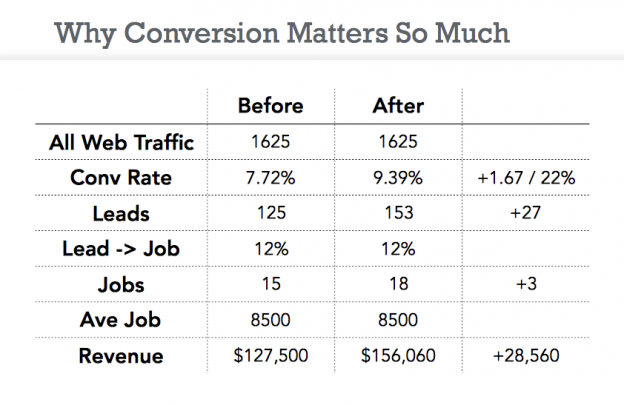
In this study of an Energy Circle client’s website, we found that a 22% improvement in conversion rate—only about 1.6 points (while keeping all other metrics including web traffic the same)—leads to an additional 3 booked jobs and a revenue bump of over $28,500.
In other words, focusing marketing dollars on improving the experience and performance of your landing pages will likely have a greater impact on your bottom line than investing those same dollars in just getting more visitors to your website (through SEO or paid search, for example).
We’re not saying SEO and paid search aren’t worth investment—they absolutely are. But harkening back to our opening metaphor, if you’re inviting people over and you want them to feel welcome and comfortable, you should probably fix up the guest rooms before they arrive!
You might be thinking, “Wait a minute, I keep a clean house! My landing pages are solid and comply with all best practices,” and that’s probably accurate. But, when it comes to seriously fine tuning UX / UI and content to a very specific audience, there is usually plenty of room for growth. In fact, during the EC webinar last week, a poll of attendees from the solar, HVAC, and home performance industries revealed that the majority (over 90%) believed there was at least some opportunity for improvement when it came to their current landing pages, with more than 40% stating they could use some serious help!
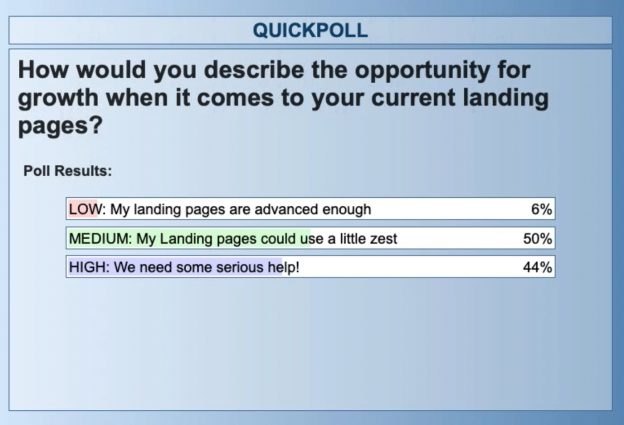
Performance Data
While conversion rate is probably the most compelling performance indicator of a successful advanced landing page, evaluating the effectiveness of your landing pages is about measuring engagement as well. (Core Goal #2: Keep ’em there!)
There are many metrics (some more meaningful than others) that we can use to assess if and how users are engaging with our landing pages.
-
Increase in Average Time Spent on Page
-
Increase in Session Duration *
-
Reduction in Bounce Rate*
-
Reduction in Exit Rate
-
Increase in Page Depth (average number of other site pages a user visited during a session that included that landing page)
We know that when we see engagement metrics improve, conversion rate improvement usually follows. Case and point: below are screenshots from Google Analytics for a home performance company’s key service landing pages, showing data from the two months before and after a template redesign and content optimization which upgraded them to “advanced” landing pages. The average time on page increased by 105%, the bounce rates and exit rates both reduced by over 35%, and the page depth increased by 118%. All of this improvement in engagement contributed to an 18% increase in conversion rate, leading to 60% more conversions than in the two months prior to the landing page upgrade.
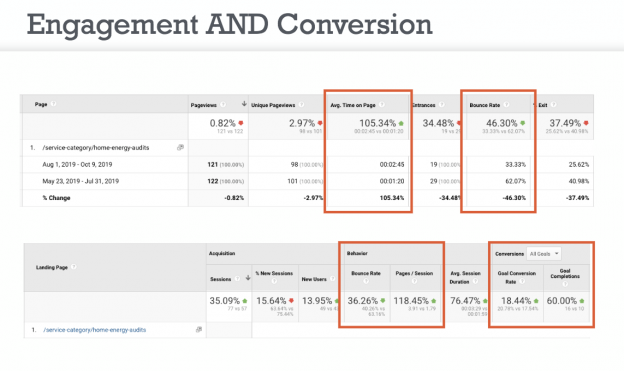
Google Analytics Data for a Energy Audit Service landing page on a home performance company’s website, showing the correlation between improved engagement and improved conversion rate over a 4 month period (2 months before to 2 months after a landing page upgrade).
Start with Core Service Pages, and Don’t Be Afraid of the Long Scroll!
The correlation between improved engagement metrics and an increase in conversions helps us identify the best place to start when deciding which landing pages would most benefit from being elevated to “advanced” landing pages. Pages that detail your business’ highest priority services or products are probably already getting a decent amount of traffic. Leverage that traffic for more efficient ROI and focus on improving the design, content, or conversion elements (like forms or calls-to-action) in order to convert more of those visitors into leads.
Additionally, because of the highly strategic and customized nature of advanced landing pages, they are very well suited to accommodate long form content. Consider publishing advanced landing pages to promote your more complex or higher price point services, which tend to require more explanation and trust building with the consumer before they’re ready to make the jump to a converted lead.
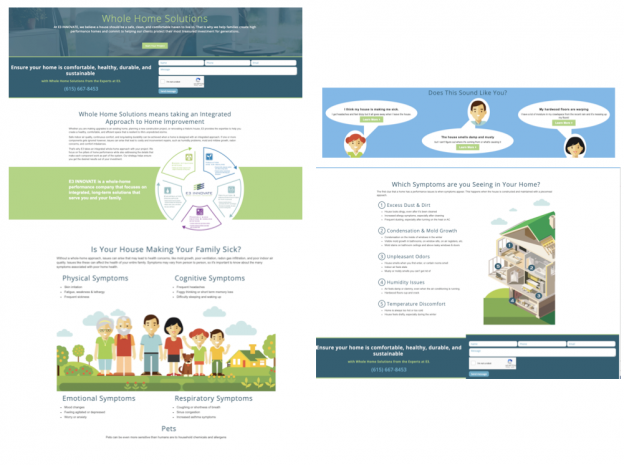
Long form pages do a better job of “telling the story” and delivering helpful, comprehensive information that answers a potential lead’s question or solves a problem, while still offering options for where to go next or what action to take throughout the page.
When a service or promotion requires a little extra time to consider and research on the user’s end, it’s worth making the landing page a place where they can do that consideration and research all in one place. Remember, more detail can lead to more clarity—it doesn’t necessarily have to mean more complex!
Blueprint for the Ideal Landing Page
Because every business is different, and every target audience is different, the purpose and goals for every landing page are going to be slightly different as well. There is not necessarily one perfect template or layout for the “ideal” landing page. There is no magic bullet!
But there are some core structural elements that most every landing page will likely need. These elements are critical to telling the story and delivering the experience needed to accomplish good user experience, and therefore good conversion:
-
Headline & Subhead (with properly structured HTML tags)
-
Compelling Call-to-Action
-
Details on Benefit to the Consumer (Value Proposition / What distinguishes you from your competition)
-
Lead Collection / Conversion Element (web form, phone number, and/or live chat option)
-
Context—Body Content (images, graphics, video, and text that clarifies everything about the service or product offered on the page—who it’s available to, what it is, why they need it, etc.)
-
Trust symbols (badges and icons that indicate any certifications, accreditations, affiliations, etc.)
-
Third Party Trust Components—customer testimonials, relatable stories / content (even a map of projects in the neighborhood or town so customers know that you know the area)
-
Safety net CTA (a final effort to convert a user before they leave the page)
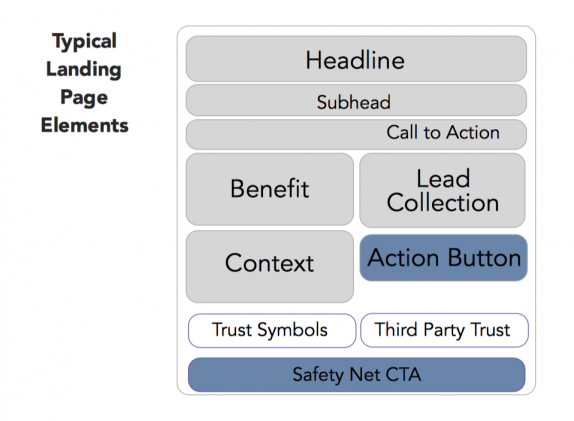
When to Use Advanced Landing Pages
Advanced landing pages don’t have to fit neatly into a box. They’re totally flexible, and can and should be adapted to accommodate your marketing goals. We have found them to be particularly effective when promoting services that require a little more explanation or education, such as:
-
Whole House and Healthy Home Services
-
Insulation and Air Sealing
-
Energy Audits
-
Battery Storage
-
Smart Home and Home Automation
-
Energy Upgrade Financing and Loan Products
-
Heat Pumps and Heat Pump Water Heaters
-
Home Electrification
While long form advanced landing pages work great to tell a more complex story, don’t let too much info get in the way of something that is relatively simple. For example, general HVAC maintenance and repair services (especially emergency services) are important lead drivers, commonly searched for, and don’t require a whole lot of explanation. All your landing page really needs to do is answer the following four questions:
-
Do you offer this service?
-
Are you available (location / timing)?
-
Are you a company I can trust?
-
How do I get in contact with you / hire you?
For these simpler pages, focus improvements and upgrades on creating a more accessible and responsive template design, writing more compelling calls-to-action, and amplifying trust symbols. Advanced landing pages don’t have to be long form to be effective, and when the concept or service is straightforward, sometimes a shorter page is best.
Speaking of the “Safety Net” CTA...
If it’s not clear already, at EC we are big believers in going the extra mile with landing pages. Advanced landing pages offer a better user experience, have better conversion rates, generate more leads, and eventually book more jobs for your home performance, HVAC, or solar business.